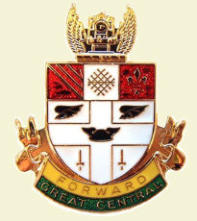The Early Years
Princes Risborough North Signal Box
The
first
railway
to
reach
Princes
Risborough
was
the
Wycombe
Railway
on
1st
August
1862,
which
saw
the
extension
of
its
single
track
line
from
High
Wycombe
run
all
the
way
to
Thame
as
part
of
its
planned
Oxford
extension. Parliamentary approval had been granted little over 12 months previously on 28 June 1861.
Next
came
another
branch
built
by
the
Wycombe
Railway,
this
time
to
Aylesbury
which
opened
on
1st
October
1863.
Following
that
less
than
a
decade
later
came
the
Watlington
and
Princes
Risborough
Railway
in
1872.
It
connected
the
Oxfordshire
towns
of
Watlington
and
Chinnor
to
the
main
GWR
network
at
Princes Risborough.
The
Princes
Risborough
North
signal
box
you
see
today
was
built
in
1904/5
as
part
of
the
Great
Western
and
Great
Central
Joint
Railway
's
“Bicester
cut
off”
route
between
Princes
Risborough
(then
on
the
Wycombe
Railway
route
from
High
Wycombe
via
Thame
to
Oxford)
and
Aynho
(on
the
Oxford
–
Banbury
line)
-
see
the
red
line
on
the
map.
This
completed
the
GWR's
“North
Main
Line”
from
Paddington
to
Birmingham
and
on
to
Liverpool
and
Birkenhead.
Previously
trains
had
to
be
routed
via
Oxford.
This
was
not
the
first
signal
box
to
be
built
at
Princes
Risborough.
There
is
reference
to
a
Wycombe
Railway
signal box (and station) dating back to 1892 for their line to Oxford.
The
North
Box
was
not
alone:
a
smaller
Princes
Risborough
South
signal
box
stood
on
the
London
side
of
the
station
on
the
other
side
of
the
line
in
what
is
now
the
station
car
park.
The
South
Box
closed
in
1968
and was demolished.
The
task
of
the
North
box
was
to
control
the
junctions
between
the
double
track
main
line
and
the
three
single
track
branches:
to
Aylesbury;
to
Watlington
(via
Chinnor);
and
to
Oxford
(via
Thame).
Without
knowing
the
history
of
the
area
it
would
be
easy
to
think
the
two
lines
that
leave
the
station
in
a
northwest
direction
around
the
left
curve
are
one
for
the
‘Up*’
line
and
one
for
the
‘Down*’.
They
were
actually
each
single, bi-directional lines, the left hand going off via Chinnor, the other via Thame.
*
Railways
historically
only
go
in
two
directions,
Up
or
Down!
The
Up
direction
refers
to
lines
going
towards London, the Down being in the opposite direction.
The
station
itself
was
a
classic
GWR
design
station
building
which
cost
£1104
9s
5d
to
build
and
additional
general
costs
of
£824
8s
0d.
It
had
two
through
platforms
facing
loop
lines
on
the
outside
of
two
centre
fast
roads.
Both
through
platforms
had
North
facing
bays
on
the
back,
and
both
bay
roads
had
engine
release
loops.
The
loops
were
necessary
so
that
the
same
single
locomotive
could
detach
from
the
train
it
had
just
pulled
in
to
the
platform
and
then
run
round
on
the
parallel
passing
loop
to
rejoin
at
what
would
now
be
the
front
of
the
train.
If
the
passing
loops
are included, Risborough was eight tracks wide with four platform faces!
One
of
those
eight
tracks
was
a
freight
by-pass
line
on
the
West
(down)
side
out
of
shot
on
the
left
in
this
more
recent
picture
(looking
North).
Princes
Risborough
North
box
can
be
seen
in
the
distance
near
the
top
of
the
picture
as
can
the
multiple
semaphore
signals
it
controlled.
The
left
hand station canopy hides the Watlington branch line and bay platform.
Note the single carriage behind loco 5420.
Click the green edged button below to take you non-stop to the next recommended destination.


















